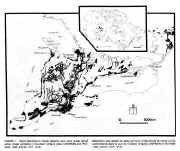|
Geographie physique et Quaternaire, Vol. XXXV, n¡ã 2 (1981), 219-229
COASTAL DUNES OF ONTARIO:
DISTRIBUTION AND GEOMORPHOLOGY
I. PETER MARTINI
Department of Land Resource
Science, University of Guelph, Guelph, Ontario N1G 2W1
¡¡
 Transverse dunes (foredunes),
parabolic dunes, rare cliff-top dunes, and blowouts are found in Ontario. Many
of these coastal dunes are landlocked on abandoned sand plains of partially
drained early-post glacial lakes and seas. Others are part of coastal systems
found at different stages of evolution along the Great Lakes. An idealized
coastal system, as is for great part well developed at Wasaga Beach, includes
the following elements: a few metres high foredunes partially deflated and
breached by wave washover; low, long, narrow, marshy zones landward from the
foredunes: the "pannes"; a wide sequence of numerous beach ridges
capped by small (2 m high) stabilized foredunes, and separated by long shallow
swales covered by water for several months of the year; intensely deflated
transverse dunes which record raised coastlines of old lakes; and finally,
high(up to 25 m) nested parabolic dunes showing progressive landward increase in
height. These high dunes have developed over sandy, gravelly bars of early
Holocene lakes, and have prograded for a short distance over lagoons. Most dune
systems found along the Great Lakes have developed in the last 3-5000 years.
Some of them have been intensely affected by man during the last two centuries,
particularly by logging, agriculture, and recreational activities. Some dune
fields have been completely flattened, others on the contrary have been
reactivated by deforestation, and new dunes have formed and have migrated
landward onto forests and cultivated fields. Transverse dunes (foredunes),
parabolic dunes, rare cliff-top dunes, and blowouts are found in Ontario. Many
of these coastal dunes are landlocked on abandoned sand plains of partially
drained early-post glacial lakes and seas. Others are part of coastal systems
found at different stages of evolution along the Great Lakes. An idealized
coastal system, as is for great part well developed at Wasaga Beach, includes
the following elements: a few metres high foredunes partially deflated and
breached by wave washover; low, long, narrow, marshy zones landward from the
foredunes: the "pannes"; a wide sequence of numerous beach ridges
capped by small (2 m high) stabilized foredunes, and separated by long shallow
swales covered by water for several months of the year; intensely deflated
transverse dunes which record raised coastlines of old lakes; and finally,
high(up to 25 m) nested parabolic dunes showing progressive landward increase in
height. These high dunes have developed over sandy, gravelly bars of early
Holocene lakes, and have prograded for a short distance over lagoons. Most dune
systems found along the Great Lakes have developed in the last 3-5000 years.
Some of them have been intensely affected by man during the last two centuries,
particularly by logging, agriculture, and recreational activities. Some dune
fields have been completely flattened, others on the contrary have been
reactivated by deforestation, and new dunes have formed and have migrated
landward onto forests and cultivated fields.
|